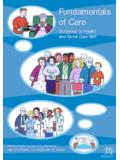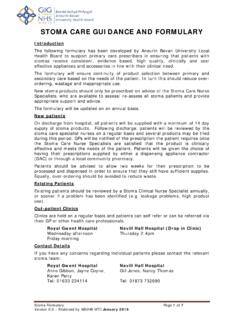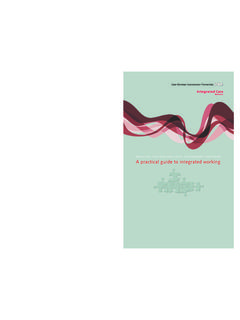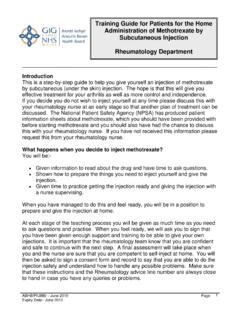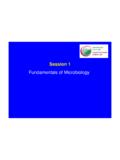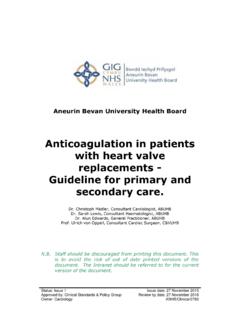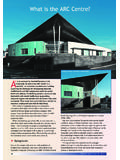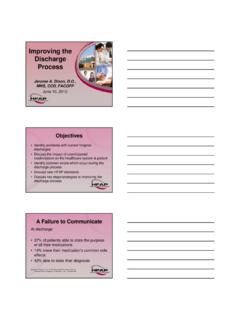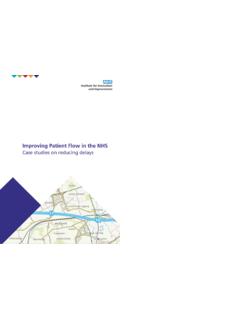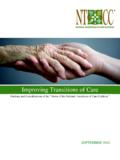Transcription of Discharge from hospital: pathway, process and practice
1 Discharge from hospital : pathway , process and practice READER INFORMATION. Policy Estates HR/Workforce Performance Management IM & T. Planning Finance Clinical Partnership Working Document Purpose Best practice Guidance ROCR Ref: Gateway Ref: 1074. Title Discharge from hospital : pathway , process and practice Author Health & Social Care Joint Unit and Change Agents Team Publication date 28 Jan 2003. Target Audience PCT CEs, NHS Trusts CEs, StHAs CEs, Care Trusts CEs, Medical Directors, Directors of PH, Directors of Nursing, PCT PEC Chairs, NHS Trust Board Chairs, SHA CEs, Allied Health Professionals, Communications Leads, Emergency Care Leads Circulation list Description This good practice guidance updates and builds on the hospital Discharge Workbook published in 1994.
2 The Government Response to the Health Select Committee Report on Delayed Discharges, issued in November 2002, indicated that the workbook would be updated to reflect the Government's commitment to tackle delayed discharges in line with its commitment in the NHS plan. Cross Ref hospital Discharge Workbook 1994. Superceded Docs hospital Discharge Workbook 1994. Action required Incorporate into Discharge planning process Timing Immediate effect Contact details Jenny Mudge Department of Health, Health and Social Care Joint Unit Room 214 Wellington House 133-155 Waterloo Road SE1 8UG.
3 020 7972 4329. For recipient use Further copies of this document are available from: Department of Health PO Box 777. Lodon SE1 6XH. Crown Copyright 2003. Produced by Department of Health 30473 1p Feb 03 (RE). CHLORINE FREE PAPER. The text of this document may be reproduced without formal permission or charge for personal or in-house use. First published: 2003. 30473/ Discharge from hospital : pathway , process and practice can also be made available on request in braille, on audio cassette tape, on disk, in large print, and in other languages on request.
4 30473/ Discharge from hospital : pathway , process and practice is available on the department's website at: Contents Foreword v Acknowledgements vii Useful abbreviations x Glossary xi 1. Introduction and overview 1. Delayed transfer of care 1. improving Discharge performance 2. The government's policy 3. Key principles 3. How to use the workbook 5. References 5. 2. Background information: policy context 7. Introduction 7. Rights and responsibilities 8. Service standards 10. Future service developments 12. References 14.
5 3. Developing a whole system approach' 15. What are the characteristics of whole system working? 15. Who is included? 17. Whole system working for effective hospital Discharge 18. The contents, characteristics and components of a good inter-agency Discharge policy 19. Action steps 22. Practical example 22. References 22. Appendices Supporting the system 23. Transport 29. Discharge planning self-assessment tool 32. 4. Involving patients and carers 35. An overview of the issues 35. Key features to achieve successful involvement 36.
6 Assessing need 37. Action steps 40. Practical examples 40. References 42. Appendices Carer's assessment checklist 43. Carer's assessment and care plan 44. Patient's and carer's leaflet 45. iii 5. Co-ordinating the patient journey 47. An overview of the key issues 47. The patient journey 49. Pre-admission assessment 50. Admission to the ward 54. Equipment provision 58. Discharge lounges 58. Transport 58. Action plan 58. Practical examples 59. Multidisciplinary and inter-agency teamwork 59. References 62. Appendices Medicines management 64.
7 Discharge checklist 69. Equipment provision 71. Discharge lounges 73. Discharge needs of people who are homeless 74. Admission of people with additional needs 76. Guidelines for the acute sector when caring for someone with a learning disability 79. Common problems and simple solutions 84. 6. Intermediate care, transitional care and sheltered housing 89. Intermediate care 89. Transitional care 91. Sheltered housing 92. Action plan 92. References 93. Appendices Housing 94. 7. Continuing health and social care 97.
8 What is continuing care? 97. Who is responsible for providing and funding continuing care? 97. Where is continuing care provided? 99. What effect does the provision of continuing care have on delayed transfers of care? 99. Assessing the need for continuing health and social care 100. The Direction on choice for accommodation 101. Dealing with disputes 102. Action plan 103. References 104. Foreword Admission to and Discharge from hospital can be a distressing time for individuals, their families and friends.
9 For most people, however, treatment will be successful and they will return to their usual way of life very quickly through the provision of an accurate diagnosis, treatment and rehabilitative service. Some people will need additional help to enable them to do so over and above their medical treatment. These needs can be many and varied and cannot be met by the NHS alone. It is increasingly evident that effective hospital discharges can only be achieved when there is good joint working between the NHS, local authorities, housing organisations, primary care and the independent and voluntary sectors in the commissioning and delivery of services including a clear understanding of respective services.
10 Without this the diverse needs of local communities and individuals cannot be met. Government policy and recent legislative changes aim to help you work more creatively across the traditional organisational boundaries. I have been impressed by the enthusiasm and commitment to achieve real improved outcomes for people and of the better use of resources that is taking place throughout England. This workbook, primarily concerned with the care of adults with physical ill health, has drawn together some of those examples of good practice to assist commissioners, practitioners and managers in their efforts to improve the processes of Discharge planning.
